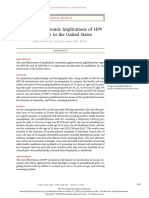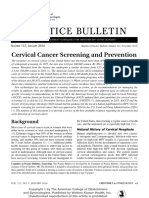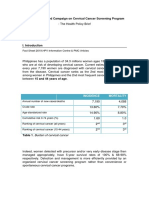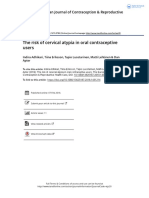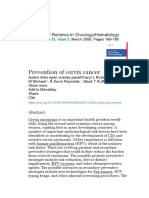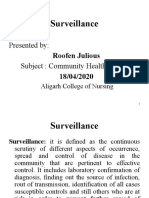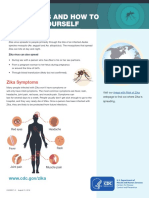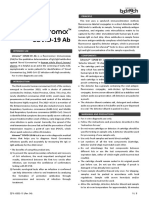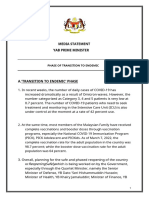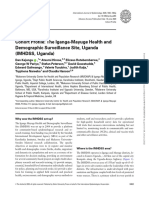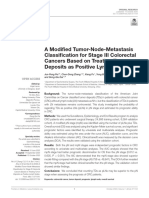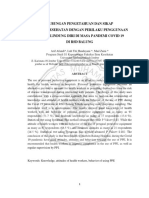Efficacy of Vaccination Against HPV Infections To Prevent Cervical Cancer in France: Present Assessment and Pathways To Improve Vaccination Policies
Efficacy of Vaccination Against HPV Infections To Prevent Cervical Cancer in France: Present Assessment and Pathways To Improve Vaccination Policies
Uploaded by
rickyCopyright:
Available Formats
Efficacy of Vaccination Against HPV Infections To Prevent Cervical Cancer in France: Present Assessment and Pathways To Improve Vaccination Policies
Efficacy of Vaccination Against HPV Infections To Prevent Cervical Cancer in France: Present Assessment and Pathways To Improve Vaccination Policies
Uploaded by
rickyOriginal Title
Copyright
Available Formats
Share this document
Did you find this document useful?
Is this content inappropriate?
Copyright:
Available Formats
Efficacy of Vaccination Against HPV Infections To Prevent Cervical Cancer in France: Present Assessment and Pathways To Improve Vaccination Policies
Efficacy of Vaccination Against HPV Infections To Prevent Cervical Cancer in France: Present Assessment and Pathways To Improve Vaccination Policies
Uploaded by
rickyCopyright:
Available Formats
Efficacy of Vaccination against HPV Infections to Prevent
Cervical Cancer in France: Present Assessment and
Pathways to Improve Vaccination Policies
Laureen Ribassin-Majed1*, Rachid Lounes1, Stephan Clemencon2
1 Laboratoire Mathematiques Appliquees a` Paris 5, Centre National de la Recherche Scientifique Unite Mixte de Recherche nu8145, Universite Paris Descartes, Sorbonne
Paris Cite, Paris, France, 2 Laboratoire Traitement et Communication de lInformation, Telecom ParisTech/Centre National de la Recherche Scientifique Unite Mixte de
Recherche nu5141, Paris, France
Abstract
Background: Seventy percent of sexually active individuals will be infected with Human Papillomavirus (HPV) during their
lifetime. These infections are incriminated for almost all cervical cancers. In France, 3,068 new cases of cervical cancer and
1,067 deaths from cervical cancer occurred in 2005. Two vaccines against HPV infections are currently available and
vaccination policies aim to decrease the incidence of HPV infections and of cervical cancers. In France, vaccine coverage has
been reported to be low.
Methods: We developed a dynamic model for the heterosexual transmission of Human Papillomavirus types 16 and 18,
which are covered by available vaccines. A deterministic model was used with stratification on gender, age and sexual
behavior. Immunity obtained from vaccination was taken into account. The model was calibrated using French data of
cervical cancer incidence.
Results: In view of current vaccine coverage and screening, we expected a 32% and 83% reduction in the incidence of
cervical cancers due to HPV 16/18, after 20 years and 50 years of vaccine introduction respectively. Vaccine coverage and
screening rates were assumed to be constant. However, increasing vaccine coverage in women or vaccinating girls before
14 showed a better impact on cervical cancer incidence. On the other hand, performing vaccination in men improves the
effect on cervical cancer incidence only moderately, compared to strategies in females only.
Conclusion: While current vaccination policies may significantly decrease cervical cancer incidence, other supplementary
strategies in females could be considered in order to improve vaccination efficacy.
Citation: Ribassin-Majed L, Lounes R, Clemencon S (2012) Efficacy of Vaccination against HPV Infections to Prevent Cervical Cancer in France: Present Assessment
and Pathways to Improve Vaccination Policies. PLoS ONE 7(3): e32251. doi:10.1371/journal.pone.0032251
Editor: Paulo Lee Ho, Instituto Butantan, Brazil
Received November 10, 2011; Accepted January 25, 2012; Published March 12, 2012
Copyright: 2012 Ribassin-Majed et al. This is an open-access article distributed under the terms of the Creative Commons Attribution License, which permits
unrestricted use, distribution, and reproduction in any medium, provided the original author and source are credited.
Funding: These authors have no support or funding to report.
Competing Interests: The authors have declared that no competing interests exist.
* E-mail: laureen.majed@parisdescartes.fr
for about 3,000 new cases per year [6] while a thousand deaths are
due to these cancers annually. Moreover, cervical cancers occur
frequently in young women [7].
Vaccination against HPV infections represents an effective way
to decrease cervical cancer incidence, particularly among young
women. Two prophylactic vaccines against HPV infections are
available in France and have been found to be highly effective in
women who have never been infected with HPV [8].
The permanent Vaccines Advisory Committees (Comite
technique des vaccinations and Conseil superieur dhygie`ne
publique de France) recommend vaccinating 14 years old
females. Moreover, a catch-up program has been offered to
women aged from 15 to 23. Females eligible for the catch-up
program either not have been sexually active yet or may report a
first sexual relationship that occurred in the year prior to
vaccination (Haute Autorite de Sante, HAS). A recent paper has
estimated vaccine coverage in France to be low: about 30% of girls
aged 14 had been vaccinated with three doses in 2007 and 2008
Introduction
Human Papillomavirus infection (HPV) is the most frequent
sexually transmitted disease. At least 70 per cent of sexually active
men and women are infected with HPV during their life span [1].
Eighty per cent of HPV infections cases are cleared in a few
months by the immune system without treatment but in the
remaining 20%, infection becomes persistent. One hundred types
of HPV have been identified: low risk types, which are responsible
for benign anogenital lesions, and high risk types, which can lead
to precancerous and cancerous lesions in the cervix. HPV-16 is the
most common genotype in developed countries [2,3].
Epidemiological studies have established a causal relationship
between HPV infections and occurrence of cervical cancer [4].
These infections have also been incriminated in anogenital, head
and neck cancers, anogenital warts and recurrent respiratory
papillomatosis among women and men.
Invasive cervical cancer is the second most common cancer
among women worldwide [5]. In France, cervical cancer accounts
PLoS ONE | www.plosone.org
March 2012 | Volume 7 | Issue 3 | e32251
Efficacy of Vaccination against HPV Infections
CIN2/3 were supposed to be infected with HPV 16/18 and
therefore could infect men.
Individuals exited the model by death (age and gender specific
using French data) or when they reached the age of 84. An
additional death rate for women with cervical cancer was
considered [6] (see Table S5).
The heterosexually mixing population was divided into 14 age
groups ([1419], [2024], [2529], [3034], [3539], [4044],
[4549], [5054], [5559], [6064], [6569], [7074], [7579],
[8084]) based on age groups of published data on cervical cancer
incidence in France [6]. We developed a demographic model
[20,25] which simulated the distribution of French population (see
Table S6, Figure S1 and Figure S2). Annual transition rates into
age groups were defined by the demographic model (see Appendix
S1).
Each age group was divided into 4 levels of sexual behavior.
The level of sexual activity was defined by the number of sexual
partners in last 12 months (0 sexual partners-including nonsexually-active individuals-, 1 partner, between 2 and 3 partners
and more than 4 partners in last year). Results from the French
survey on sexual behavior [26] were used to derive the distribution
between group of sexual behavior (see Table S1). Mixing between
sexual activity groups was quantified by the mixing matrix as
described by Garnett and Anderson [27]. The probability for
someone from group l defining sexual-behavior to form a
partnership with someone from group o is defined by:
[9]. Therefore, the potential impact of vaccination has to be
assessed considering observed vaccination coverage.
Since the recent introduction of vaccination policies in France, a
reduction of cervical cancers and pre-cancerous lesions has been
expected. As cervical cancers usually occur 15 years after HPV
infections, mathematical models are useful to assess an expected
reduction in cancer cases. In these models, vaccine coverage in
young women is taken into account.
Various dynamic models have been published to assess the
potential impact of HPV vaccination in several countries. Some of
them are cohort models [1018] and others are deterministic or
hybrid models [1923]. Deterministic models directly allow us to
estimate both the direct and indirect (herd immunity) benefits of
vaccination [24].
In this paper, we present a deterministic model for the
heterosexual transmission of HPV and its progression to cervical
lesions and cervical cancer. We estimated the potential impact of
vaccination on the reduction of cervical cancer incidence in
French women. We first studied the current vaccine coverage to
assess vaccine efficacy. Then, vaccine efficacy was assessed in
different settings: adding vaccine coverage in boys and young men,
achieving higher vaccine coverage in women and adding vaccine
coverage in females under 14.
Methods
Dynamic Model Structure
We used Scilab-5.1.1 software (http://www.scilab.org/fr) to
design a deterministic model for heterosexual transmission of HPV
types 16 and 18. We developed a system of 784 ordinary
differential equations (see Table S7). We set the population size in
the model to 100,000 individuals, equally divided into females and
males. The epidemiologic model simulated heterosexual transmission of HPV-16/18 infections in males and females and
progression to CIN1 (cervical intraepithelial neoplasia stage 1),
CIN2/3 (cervical intraepithelial neoplasia stage 2/3) and cervical
cancer for females (see flow diagram on Figure 1). Description of
variables and parameters can be found in Appendix S1 (Table S4).
Fourteen-year-old persons entered the model at a genderspecific and sexual activity-specific rate. Sexually active men and
women could be infected with HPV 16/18 if they had had sexual
intercourse with infected individuals. Women with CIN1 or
wlo ~e No Co z(1{e)dlo
4
P
Ns Cs
s~1
With No being the proportion of individuals in sexual-activity
group o, co representing the average number of annual partners in
group o, the parameter e described the degree of mixing between
sexual activity groups which may vary from fully assortative (e = 0,
when individuals have sexual partners in the same sexual activity
class) to fully random (e = 1). Mixing between sexual activity
groups was assumed to be preferentially assortative (e = 0.4).
Force of Infection
The force of infection by gender depends on: probabilities of
transmission by partnership (not per sex act) from an infected
Figure 1. Flow diagram in non-vaccinated population. For one age-group j (j = 114) and one group of sexual behavior l (l = 14): Black solid
arrows represent infection or progression of the disease; black dotted arrows represent clearance of infection or regression of the disease; gray
dotted arrows represent exit of the model (due to death or age .84); bold arrows represent specific mortality due to cervical cancer.
doi:10.1371/journal.pone.0032251.g001
PLoS ONE | www.plosone.org
March 2012 | Volume 7 | Issue 3 | e32251
Efficacy of Vaccination against HPV Infections
individual to a susceptible (sf and sm); number of sex partner in
last 12 months (cl = 0, 1, 23, +4); proportion of infected
individuals in the pool of sexual partner according to their agegroup and level of sexual behavior. We developed a mixing matrix
rg,i,k appropriate for the sexually active population in France,
which gives the proportion of individuals of gender g, in age-group
i who have sexual partners in age-group k (see Table S2).
susceptible one) have been estimated to 0.25 (female) and 0.20
(male).
Among infected females, the rates of progression to various
stages of cervical disease (CIN1, CIN2/3 and cervical cancer) were
estimated for each age-group (Table S3). We compared the agespecific incidence of cervical cancer predicted by the model with
French published data [6,7]. Incidence rates of cervical cancer in
France are estimated using data from cancer registries (www.invs.
fr). Seventy percent of cervical cancers are due to HPV types 16/
18. Age-specific incidence rates of cervical cancer predicted by the
model were similar to the incidence rates of cervical cancers
attributed to HPV 16/18 in France within a precision of 10%.
Predicted HPV prevalence had a shape and a peak similar to that
reported in literature data [28,29,32]. Incidence rates of mortality
predicted by the model were also close to published rates [7,33].
Transmission model data
In a fitting procedure, we derived the probabilities of
transmission of HPV 16/18 (from an infected individual to a
susceptible) for both sexes and age-specific progression rates to
different stage of cervical disease (CIN1, CIN2/3 and cervical
cancer). A set of parameters which matched HPV 16/18
prevalence [28,29] and age-specific incidences of cervical cancer
[30] was selected. As HPV types 16 and 18 are responsible for
70% of all the causes of cervical cancer [31], we multiplied by 0.7
the published French incidence rate of cervical cancer to assess the
incidence rate of cervical cancer due to HPV types 16 and 18 (for
French women). Regression rates of cervix lesions were defined
using literature data [20].
Sensitivity analysis
Sensitivity analyses were conducted to assess the effect of
parameter variations on model results. The degree of sexual
mixing e, which can vary between 0 (fully assortative) and 1 (fully
random), was initially set to 0.4. We tested the effect of a value for
e closer to sexual mixing fully random (e = 0.8) on the endemic
prevalence of HPV infections in male and female. Although
vaccine efficacy was initially set to 90%, in sensitivity analyses, we
set vaccine efficacy to 60%. Thus, we studied the impact of
vaccination on HPV prevalence and cervical cancer incidence
using a low (60%) vaccine efficacy.
Vaccine characteristics
We divided the population into vaccinated and unvaccinated
categories. Individuals entered the model at 14 years old (being
vaccinated or not). Individuals in the youngest age groups ([1419]
and [2024]) could be vaccinated after entrance into the model in
accordance with the French vaccine program and then moved to
vaccinated categories. We considered several vaccination scenarios. Immunity from the vaccine was assumed to be sustained
lifelong and vaccine efficacy was assumed to be 90%. In the five
scenarios considered, vaccine coverage was assumed to be constant
in time. In the first scenario, coverage of vaccination (using 3 doses
of vaccines) was set to that observed in France in 2009 [9]: 30% of
women aged 1419 and 10% of women aged 2024 (Table 1). In
the second scenario, we added vaccination coverage in boys and
men with similar rates to the women in scenario 1. We thereafter
defined hypothetical high coverage in women only (80%) and both
genders in scenarios 3 and 4 respectively. Finally, in scenario 5,
young girls could be vaccinated before age of 14 with a highest
coverage than for girls aged 14 to 24 (50% versus 30%); in this
scenario, there was no vaccination in men.
Results
HPV infection prevalence
Tables 2 and 3 show predicted prevalence of HPV 16/18
infections in each considered scenario of vaccination coverage. All
vaccination strategies considered against HPV 16/18 led to a
sizeable decrease in prevalence in males and females 20 and 50
years after vaccination introduction (see Figure S4 and Figure S5).
There was a modest effect on the prevalence of HPV infections
when scenarios included vaccination coverage in men and women
compared to those considering vaccination coverage only in
females. For instance, in France, current vaccination coverage
among females lead to a 52% reduction of HPV infection
prevalence 20 years after the introduction of the vaccine, while
adding vaccination with a similar coverage in boys and young men
yielded a 59% reduction in HPV infection prevalence.
Improving vaccine coverage (scenario 3 and 4) decreased HPV
prevalence more importantly; in addition, the impact of the
vaccines was observed earlier in time.
Scenario 5, which considered an additional vaccination of girls
before 14, yielded a better impact on HPV prevalence among
Model validation
To validate the model, we considered the epidemiological data
before vaccination introduction and compared it with the steadystate estimates of the deterministic model for non-vaccinated
individuals (see Figure S3). Probabilities of transmission of HPV
16/18 (per partnership, from an infected individual to a
Table 1. Scenarios of vaccination considered in simulations.
Vaccine coverage
Scenario 1
Scenario 2
Scenario 3
Scenario 4
Women
Scenario 5
,14: 50%
[1419]
30%
30%
80%
80%
30%
[2024]
10%
10%
80%
80%
30%
[1419]
30%
80%
[2024]
10%
80%
Men
doi:10.1371/journal.pone.0032251.t001
PLoS ONE | www.plosone.org
March 2012 | Volume 7 | Issue 3 | e32251
Efficacy of Vaccination against HPV Infections
Table 2. Prevalence of HPV 16/18 for women in each scenario 10, 20 and 50 years after initiation of vaccination (t = 0).
Prevalence of HPV 16/18 for women
10 years
20 years
50 years
Without vaccination
20.2%
20.2%
20.2%
Scenario 1
14.4% (228.7%)
9.8% (251.7%)
2.6% (287.2%)
Scenario 2
13.7% (232.2%)
8.31% (258.9%)
0.85% (295.8%)
Scenario 3
11.0% (245.5%)
6.05% (270.0%)
0.6% (297.0%)
Scenario 4
10.1% (250%)
4.69% (276.8%)
0.09% (299.6%)
Scenario 5
12.2% (239.6%)
6.96% (265.6%)
0.9% (295.6%)
Vaccine coverage was supposed constant in each scenario. In parentheses, % of reduction in HPV prevalence compared to the case without vaccination.
doi:10.1371/journal.pone.0032251.t002
to HPV 16/18 may be expected 20 years after the introduction of
the vaccine (see Table 4 and Figure S6). A modest reduction may
be expected 10 years after vaccine introduction (27.3%) due to
the natural history of cervical cancer: indeed, cervical cancers can
occur several decades after HPV infections. Scenario 1 predicted
an 83% reduction of cervical cancer cases due to HPV 16/18 at 50
years after vaccine introduction, assuming constant vaccine
coverage and screening rates (Table 4).
Adding vaccination among males (scenario 2) to current
recommendations (considered in scenario 1) led to a similar
reduction in cervical cancer.
Considering a high coverage of vaccination (80% in scenario 3)
for women, a halving of numbers of new cervical cancers would be
expected 20 years after vaccine introduction. Adding vaccination
in men would not lead to a much better reduction in cervical
cancer cases (scenario 4).
females than scenario 2. This scenario considered vaccination with
a similar coverage in males and females aged 14 to 24.
The deterministic model that we developed takes into account
the reduction of male HPV 16/18 prevalence due to female
vaccination. Table 3 shows the expected reduction in male
prevalence for each scenario. The reduction of HPV prevalence in
men was similar to that in women in case of males and females
vaccination (in scenarios 2 and 4).
All in all, scenarios that considered vaccination only in females
had a lower impact on the reduction of HPV prevalence in males
compared to females.
Cervical cancer (Table 4)
Considering current vaccine coverage and screening in France
(scenario 1), a 32% reduction of incidence of cervical cancers due
Table 3. Prevalence of HPV 16/18 for men in each scenario 10, 20 and 50 years after initiation of vaccination (t = 0).
Prevalence of HPV 16/18 for men
10 years
20 years
50 years
Without vaccination
19.4%
19.4%
19.4%
Scenario 1
15.1% (222.2%)
10.9% (243.8%)
3.7% (280.9%)
Scenario 2
13.1% (232.5%)
7.8% (259.8%)
0.8% (295.9%)
Scenario 3
12.2% (237.1%)
7.3% (262.4%)
1.1% (294.3%)
Scenario 4
9.6% (250.5%)
4.3% (277.8%)
0.1% (299.5%)
Scenario 5
13.3% (231.4%)
8.2% (257.7%)
1.5% (292.3%)
Vaccine coverage was supposed constant in each scenario. In parentheses, % of reduction in HPV prevalence compared to the case without vaccination.
doi:10.1371/journal.pone.0032251.t003
Table 4. Incidence of cervical cancer due to HPV 16/18 in French women in each scenario 10, 20 and 50 years after initiation of
vaccination (t = 0).
Time after introduction of vaccine
10 years
20 years
50 years
100 years
Without vaccination
9.6
9.6
9.6
9.6
Scenario 1
8.9 (27.3%)
6.5 (232.3%)
1.6 (283%)
0.5 (294.8%)
Scenario 2
8.7 (29.4%)
6.0 (237.5%)
0.8 (291.7%)
0.02 (299.8%)
Scenario 3
8.1 (215.6%)
4.8 (250%)
0.5 (294.8%)
0.05 (299.5%)
Scenario 4
7.9 (217.7%)
4.2 (256.3%)
0.2 (297.9%)
,1025 (2100%)
Scenario 5
8.5 (211.5%)
5.3 (244.8%)
0.7 (292.7%)
0.07 (299.3%)
Vaccine coverage was supposed constant in each scenario. In parentheses, % of reduction in cervical cancer incidence compared to the case without vaccination.
doi:10.1371/journal.pone.0032251.t004
PLoS ONE | www.plosone.org
March 2012 | Volume 7 | Issue 3 | e32251
Efficacy of Vaccination against HPV Infections
subpopulations of females due to vaccination coverage of other
individuals.
In the fitting procedure, probabilities of HPV 16/18 transmission for women and men were estimated to be of 0.25 and 0.20
respectively. The values that were yielded from our model are
close to published estimates from fitted deterministic models for
HPV [19,23]: in the susceptible-infected-susceptible (SIS) deterministic model developed by Taira et al [23], age-specific
probabilities ranged from 0.15 to 0.35.
Screening of precancerous lesions of the cervix and cervical
cancer using cervical smear tests is recommended in France.
Screening coverage has been estimated to be 58.7% in women of
25 to 65 years old in 2005; however, significant discrepancies were
observed between age-groups [34]. Screening was not directly
integrated in our model as we did not stratify on screening status.
Some authors distinguished between regularly screened women
and never-screened women [20]. Nonetheless, epidemiological
data regarding screening of cervical cancer and cervix precancerous lesions are limited in France. Therefore, our model was fitted
on incidence of cervical cancer in France and considered
regression of cervix precancerous lesions due to spontaneous
regression or treatment after screening. Screening represents a
complementary tool to prevent cervical cancers, especially in case
of precancerous lesions due to other high-risk HPV types than 16/
18 whereas current available vaccines protect against HPV16/18,
which are responsible for 70% of cervical cancers.
The study could not take into consideration future changes in
screening programs, using new screening policies or new screening
technologies on the market. In France, in 2010 Public Health
Agency (HAS) proposed to organize cervical cancer screening to
improve screening coverage. Moreover, use of new screening tools
may also modify current epidemiological data on HPV infections
and related cervical cancers. In the USA, the ACOG guidelines
(2009) and the American Cancer Society (2003) recommended
HPV-plus-pap testing in women aged 30 and older [35]. However,
in France, Public Health policies explicitly recommend the use of
HPV testing only in cases of abnormal cytology (www.has-sante.fr).
Efficacy of vaccination was assumed to last lifelong. Consequently, we did not include the need for vaccine booster shots in
our model. The protective effect of the vaccines is known to last at
least several years [36,37] and the need for boosters is currently
unknown.
The sophistication of deterministic models by adding strata
corresponding to uncertain data may lead to computational
difficulties and increase the uncertainty of outputs and parameters.
Thus, screening and use of booster shots were not included in our
model.
In sensitivity analyses that investigated the effect of an increase of
the sexual mixing parameter (e), we observed a decrease of HPV
16/18 prevalence after using a high value of e. This result is
consistent with that reported in Garnett and Anderson paper [27].
We observed that in the presence of frequent completely random
sexual mixing (when the value of e is far from the assortative sexual
mixing corresponding to e = 0), the infection is less likely to persist
endemically [27]. An explanatory mechanism regarding this finding
suggests that individuals in the higher sexually active group transmit
the infection to individuals in other sexual behavior groups which
are less sexually active and less likely to transmit infection.
This analysis shows that the value of e used in our base case
modeling is consistent with endemic prevalence of HPV infections.
Sexual mixing seems to be preferentially close to assortative case.
The modeling of sexual mixing that we developed in this paper
could be used in other models corresponding to the French sexual
behavior.
In scenario 5, females were vaccinated before 14 with a better
coverage than females over 14 (50% versus 30%). This scheme led
to better results than those from scenario 1 representing current
vaccination policy in France. A 45% reduction in cervical cancer
incidence could be expected 20 years after vaccine introduction in
scenario 5 while scenario 1 yielded a 32% reduction in cervical
cancer incidence.
Beyond discrepancies in terms of vaccination impact due to
vaccination policies, the scenarios we considered predicted a
significant reduction in cervical cancers and infections due to HPV
16/18. A disappearance of cervical cancer due to HPV 16/18
could be expected in a time horizon of 100 years (Table 4). The
impact of vaccination on the specific mortality due to cervical
cancer appears after decades (Table 5). A reduction by half of
annual deaths by cervical cancer could be expected 50 years after
the initiation of the vaccine.
Sensitivity analyses
In sensitivity analysis, we tested the impact of an increase of the
sexual mixing parameter that corresponded to an augmentation of
random mixing. A high value of the sexual mixing parameter
(e = 0.8) led to a 2% reduction of endemic prevalence of HPV
infections in males and females compared to the initial value of e
(0.4).
A lower efficacy of vaccine (60%) reduced the impact on HPV
prevalence and cervical cancer incidence. For instance, using
scenario 1, model predictions yielded 50 years after introduction of
vaccine a 25% higher HPV prevalence in females and a two-fold
increase of cervical cancer incidence compared to scenario 1 with
a 90% efficacy of vaccine.
Discussion
We developed a dynamical model for HPV transmission in a
heterosexual population to assess the impact of vaccination against
HPV infections on the incidence of cervical cancer in France. We
considered current vaccination policies and compared several
vaccination scenarios. We confirmed the effectiveness of vaccination against HPV to prevent infections and cervical cancers using
deterministic modeling [19,20,21,23]. However, the impact of
vaccination differed according to the various scenarios considered
in our paper. Vaccination coverage among young females under
14 and higher vaccination coverage in currently targeted females
(in France) improved the prevention of infections and cervical
cancers due to HPV 16/18 significantly.
The use of a deterministic model in our study allowed us to take
into account herd immunity, which corresponds to a decrease of
HPV 16/18 infections and cervical cancers in non-vaccinated
Table 5. Expected Diminution of number of deaths (per year)
due to cervical cancer after introduction of vaccine compared
to number of deaths without vaccine.
Time after introduction of vaccine
20 years 50 years 100 years
Scenario 1
25%
247%
288%
Scenario 2
26%
256%
297.5%
Scenario 3
28.84%
264%
297.2%
Scenario 4
210.58%
271%
299.4%
Scenario 5
27.16%
259%
296.17%
doi:10.1371/journal.pone.0032251.t005
PLoS ONE | www.plosone.org
March 2012 | Volume 7 | Issue 3 | e32251
Efficacy of Vaccination against HPV Infections
respiratory papillomatosis, cancers of the anus, penis, vagina,
vulva, and head and neck). Vaccination against HPV 16/18
infection is likely to reduce incidence of other cancers in the
anogenital area in males and female. Reduction of HPV-16/18
prevalence in men due to female vaccination could reduce the
incidence of some male cancers. These additional potential
benefits of HPV 16/18 vaccination have to be investigated by
developing specific dynamic models that consider the natural
history of the diseases.
Finally, some recent studies have shown the bivalent vaccines
protective effect against high-risk HPV types, which are not
targeted by it (HPV types 31 and 45) [48,49]. In this case, the
model may underestimate the benefit of vaccination on the
reduction of cervical cancer incidence as we did not take into
account cross-protection in our model.
In conclusion, we developed a deterministic model of HPV
heterosexual transmission and progression to cervical cancer to
assess the epidemiologic impact of HPV vaccination in France.
While current vaccination policies may decrease cervical cancer
incidence in France significantly, other complementary strategies
could be employed for females to improve vaccination efficacy.
Efficacy of both vaccines against HPV has been evaluated in
several randomized controlled trials [3638]. While vaccines are
highly effective in women who have never been infected with HPV
16/18, efficacy of vaccines could drop in women who have been
infected prior to vaccination. We considered in the base case
scenario a 90% efficacy of the vaccine against HPV 16/18
infection and 60% in sensitivity analysis. Sensitivity analysis
showed that if vaccine efficacy is poor, impact of vaccination on
the reduction of diseases linked to HPV 16/18 will be attenuated.
In previous papers assessing the impact of HPV vaccination,
assumed vaccine coverage had very high reaching values between 80% and 100%. Current vaccine coverage in France
has been estimated to be low, under 30%, and diminishing over
time [9]. Consequently, the impact of vaccination has to be
assessed using real life coverage data. In the first scenario, we
considered the female vaccine coverage (30%) that is currently
reached in France. In the other scenarios of female vaccination
(scenarios 3 and 5) we considered realistic alternatives. Finally, we
studied scenarios in which males were also vaccinated (scenario 2
and 4).
In the first scenario, we estimated the impact of vaccination on
HPV prevalence in male and female, on cervical cancer and on
specific mortality due to cervical cancer in the horizon of 10, 20,
50 and 100 years. We considered the vaccine coverage that was
observed in France at the beginning of the vaccination campaign
(in 2007 and 2008). This scenario predicts a decrease in cervical
cancer incidence due to HPV 16/18 by one third 20 years after
introduction of vaccine and a halving of deaths by cervical cancer.
In this scenario, we considered vaccine coverage to be constant in
time. However, female vaccine coverage in France is decreasing.
While 33.3% of girls aged 14 in 2007 were vaccinated with 3 doses
of the vaccine, only 23.7% and 5.4% of girls aged 14 were
vaccinated respectively in 2008 and 2009 [9]. Therefore, the
expected effect of the first scenario is probably over-estimated in
this paper.
In Scenario 3, we considered a high vaccine coverage for
women and young girls (80%), which yielded a better impact of
vaccination than scenario 1. In countries where school-based
vaccination programs have been implemented (The United
Kingdom and Australia), these vaccine coverage rates have been
reached [39,40]. It may be difficult to implement such a program
in France, as a previous school-based program of vaccination
against hepatitis B failed due to controversies [41].
In scenario 5, young girls could be vaccinated before 14. In
Europe, many countries recommend vaccination for females aged
12 [42]. Vaccination of young girls before 14 may improve vaccine
coverage and impact of vaccination in France. A better
compliance with complete vaccination (using 3 shots) is observed
in young females [9] who are little likely to be infected with HPV
prior to vaccination. However, the need of booster shots is still
unknown [36,37]. Nevertheless, if the long term efficacy of the
vaccine is to be confirmed, vaccination coverage among younger
girls will certainly improve the impact of vaccination. The French
committee of vaccination recommended the vaccine for girls aged
14 in 2006 [43]. We also investigated the possible vaccination of
boys and young men [4447]. In scenarios 2 and 4, we assessed
the impact of an additional male vaccination on the reduction of
HPV 16/18 prevalence (in males and females) and of cervical
cancer incidence in females. Performing vaccination in men
improves moderately the effect on HPV 16/18 prevalence and
cervical cancer incidence compared to vaccination strategies in
females only.
In this paper, we did not assess the impact of vaccination on
other cancers or diseases due to HPV 16/18 infections (Recurrent
PLoS ONE | www.plosone.org
Supporting Information
Appendix S1 Description of the mathematical model.
(DOC)
Figure S1 Distribution of women aged 14 to 84. Data
observed in France on 01/01/2006 in blue (www.insee.fr) versus
predicted by the demographic model in green.
(EPS)
Figure S2 Distribution of men aged 14 to 84. Data
observed in France on 01/01/2006 in blue (www.insee.fr) versus
predicted by the demographic model in green.
(EPS)
Figure S3 Number of new cases of cervical cancer due
to HPV 16/18 for 100,000 women per year. Published data
in blue [1], predicted by the model in green.
(EPS)
Figure S4 Female prevalence of HPV 16/18 infection
since introduction of vaccination (t = 0) in each scenario.
(TIF)
Figure S5 Male prevalence of HPV 16/18 infection since
introduction of vaccination (t = 0) in each scenario.
(TIF)
Figure S6 Evolution of cervical cancer incidence for
French women (number of new diagnosed cases annually per 100,000 women) after introduction of vaccination (t = 0).
(TIF)
Table S1 Initial distribution in the model in the 4
sexual-activity groups.
(DOC)
Table S2 Mixing matrix between age-group. Proportion
of individuals who have sexual contacts with partners in youngest
age-group (,), the same age-group ( = ) or older age group (.).
(DOC)
Table S3 Models parameters.
(DOC)
Table S4 Description of variables and parameters.
(DOC)
6
March 2012 | Volume 7 | Issue 3 | e32251
Efficacy of Vaccination against HPV Infections
Table S5 French mortality rates.
Acknowledgments
(DOC)
The authors would like to thank the referees for their comments, Bilal
Majed for his invaluable help and Carole Birkan-Berz for her assistance in
the preparation of the manuscript in English.
Distribution of French population aged 14 to
84 (01/01/2006), source: National Institute of Statistics
(INSEE).
(DOC)
Table S6
Author Contributions
Table S7 Description of matrices used in implementa-
Conceived and designed the experiments: LM RL SC. Performed the
experiments: LM RL SC. Analyzed the data: LM RL SC. Contributed
reagents/materials/analysis tools: LM RL SC. Wrote the paper: LM RL.
tion.
(DOC)
References
1.
2.
3.
4.
5.
6.
7.
8.
9.
10.
11.
12.
13.
14.
15.
16.
17.
18.
19.
20.
21.
22.
23.
24. Garnett GP (2005) Role of herd immunity in determining the effect of vaccines
against sexually transmitted disease. J Infect Dis 191 Suppl 1: S97106.
25. Hethcote HW (1997) An age-structured model for pertussis transmission. Math
Biosci 145: 89136.
26. Bajos N, Bozon M, Beltzer N (2008) Enquete sur la sexualite en France :
pratiques, genre et sante. Paris: Decouverte. 609 p.
27. Garnett GP, Anderson RM (1993) Contact tracing and the estimation of sexual
mixing patterns: the epidemiology of gonococcal infections. Sex Transm Dis 20:
181191.
28. Nielson CM, Harris RB, Flores R, Abrahamsen M, Papenfuss MR, et al. (2009)
Multiple-type human papillomavirus infection in male anogenital sites:
prevalence and associated factors. Cancer Epidemiol Biomarkers Prev 18:
10771083.
29. Ralston Howe E, Li Z, McGlennen RC, Hellerstedt WL, Downs LS, Jr. (2009)
Type-specific prevalence and persistence of human papillomavirus in women in
the United States who are referred for typing as a component of cervical cancer
screening. Am J Obstet Gynecol 200: 245 e241247.
30. Duport N (2006) Donnees epidemiologiques sur le cancer du col de luterus/etat
des connaissances. Saint Maurice: InVS.
31. Clifford G, Franceschi S, Diaz M, Munoz N, Villa LL (2006) Chapter 3: HPV
type-distribution in women with and without cervical neoplastic diseases.
Vaccine 24 Suppl 3: S3/2634.
32. Peto J, Gilham C, Deacon J, Taylor C, Evans C, et al. (2004) Cervical HPV
infection and neoplasia in a large population-based prospective study: the
Manchester cohort. Br J Cancer 91: 942953.
33. Belot A, Grosclaude P, Bossard N, Jougla E, Benhamou E, et al. (2008) Cancer
incidence and mortality in France over the period 19802005. Rev Epidemiol
Sante Publique 56: 159175.
34. Duport N (2008) Donnees epidemiologiques sur le cancer du col de luterus/etat
des connaissances. Saint Maurice: INVS.
35. Jin XW, Sikon A, Yen-Lieberman B (2011) Cervical cancer screening: Less
testing, smarter testing. Cleve Clin J Med 78: 737747.
36. Castellsague X, Munoz N, Pitisuttithum P, Ferris D, Monsonego J, et al. (2011)
End-of-study safety, immunogenicity, and efficacy of quadrivalent HPV (types 6,
11, 16, 18) recombinant vaccine in adult women 2445 years of age. Br J Cancer
105: 2837.
37. Paavonen J, Naud P, Salmeron J, Wheeler CM, Chow SN, et al. (2009) Efficacy
of human papillomavirus (HPV)-16/18 AS04-adjuvanted vaccine against
cervical infection and precancer caused by oncogenic HPV types (PATRICIA):
final analysis of a double-blind, randomised study in young women. Lancet 374:
301314.
38. Rambout L, Hopkins L, Hutton B, Fergusson D (2007) Prophylactic vaccination
against human papillomavirus infection and disease in women: a systematic
review of randomized controlled trials. CMAJ 177: 469479.
39. UK Department of Health website () HPV Vaccination Programme: Provisional
data, as submitted by PCTs, for First and Second dose vaccine uptake, for the
month ending 28 February 2010. Available: http://www.dh.gov.uk/prod
consum h/groups/dh digitalassets/documents/digitalasset/dh 115153.pdf. Accessed 2011 Aug 4.
40. Brotherton JM, Deeks SL, Campbell-Lloyd S, Misrachi A, Passaris I, et al.
(2008) Interim estimates of human papillomavirus vaccination coverage in the
school-based program in Australia. Commun Dis Intell 32: 457461.
41. Denis FL-BD (2006) Mass vaccination against hepatitis B: the French example.
Curr Top Microbiol Immunol 304: 115129.
42. ECCA European Cervical Cancer Association website () HPV vaccination
accross Europe. Available: http://www.ecca.info/fr/ecca-publications.html.
Accessed 2011 Jun 5.
43. Haut Conseil Sante Publique website () AVIS DU COMITE TECHNIQUE
DES VACCINATIONS et du CONSEIL SUPERIEUR DHYGIENE
PUBLIQUE DE FRANCE SECTION DES MALADIES TRANSMISSIBLES
Relatif a` la vaccination contre les papillomavirus humains 6, 11, 16 et 18
(seances du 9 mars 2007). Available: http://www.hcsp.fr/docspdf/cshpf/
a_mt_090307_papillomavirus.pdf. Accessed 2011 Dec 27.
44. Brisson M, van de Velde N, Franco EL, Drolet M, Boily MC (2011) Incremental
impact of adding boys to current human papillomavirus vaccination programs:
role of herd immunity. J Infect Dis 204: 372376.
45. Castle PE, Scarinci I (2009) Should HPV vaccine be given to men? BMJ 339:
b4127.
Syrjanen K, Hakama M, Saarikoski S, Vayrynen M, Yliskoski M, et al. (1990)
Prevalence, incidence, and estimated life-time risk of cervical human
papillomavirus infections in a nonselected Finnish female population. Sex
Transm Dis 17: 1519.
Clifford GM, Smith JS, Plummer M, Munoz N, Franceschi S (2003) Human
papillomavirus types in invasive cervical cancer worldwide: a meta-analysis.
Br J Cancer 88: 6373.
Pannier-Stockman C, Segard C, Bennamar S, Gondry J, Boulanger JC, et al.
(2008) Prevalence of HPV genotypes determined by PCR and DNA sequencing
in cervical specimens from French women with or without abnormalities. J Clin
Virol 42: 353360.
Munoz N (2000) Human papillomavirus and cancer: the epidemiological
evidence. J Clin Virol 19: 15.
Parkin DM, Pisani P, Ferlay J (1999) Estimates of the worldwide incidence of 25
major cancers in 1990. Int J Cancer 80: 827841.
Remontet L, Esteve J, Bouvier AM, Grosclaude P, Launoy G, et al. (2003)
Cancer incidence and mortality in France over the period 19782000. Rev
Epidemiol Sante Publique 51: 330.
Guizard AVTB (2008) Estimation de lincidence et de la mortalite par cancer en
France de 1980 a` 2005. Institut de Veille Sanitaire.
Munoz N, Kjaer SK, Sigurdsson K, Iversen OE, Hernandez-Avila M, et al.
(2010) Impact of human papillomavirus (HPV)-6/11/16/18 vaccine on all
HPV-associated genital diseases in young women. J Natl Cancer Inst 102:
325339.
Fagot JP, Boutrelle A, Ricordeau P, Weill A, Allemand H (2011) HPV
vaccination in France: uptake, costs and issues for the National Health
Insurance. Vaccine 29: 36103616.
Bergeron C, Largeron N, McAllister R, Mathevet P, Remy V (2008) Costeffectiveness analysis of the introduction of a quadrivalent human papillomavirus
vaccine in France. Int J Technol Assess Health Care 24: 1019.
Brisson M, Van de Velde N, De Wals P, Boily MC (2007) The potential costeffectiveness of prophylactic human papillomavirus vaccines in Canada. Vaccine
25: 53995408.
El Hasnaoui A, Demarteau N, Granados D, Standaert B, Detournay B (2011)
Public health impact of human papillomavirus vaccination on prevention of
cervical cancer in France. Int J Public Health.
Goldhaber-Fiebert JD, Stout NK, Ortendahl J, Kuntz KM, Goldie SJ, et al.
(2007) Modeling human papillomavirus and cervical cancer in the United States
for analyses of screening and vaccination. Popul Health Metr 5: 11.
Goldie SJ, Grima D, Kohli M, Wright TC, Weinstein M, et al. (2003) A
comprehensive natural history model of HPV infection and cervical cancer to
estimate the clinical impact of a prophylactic HPV-16/18 vaccine. Int J Cancer
106: 896904.
Jit M, Choi YH, Edmunds WJ (2008) Economic evaluation of human
papillomavirus vaccination in the United Kingdom. BMJ 337: a769.
Kohli M, Ferko N, Martin A, Franco EL, Jenkins D, et al. (2007) Estimating the
long-term impact of a prophylactic human papillomavirus 16/18 vaccine on the
burden of cervical cancer in the UK. Br J Cancer 96: 143150.
Myers ER, McCrory DC, Nanda K, Bastian L, Matchar DB (2000)
Mathematical model for the natural history of human papillomavirus infection
and cervical carcinogenesis. Am J Epidemiol 151: 11581171.
Suarez E, Smith JS, Bosch FX, Nieminen P, Chen CJ, et al. (2008) Costeffectiveness of vaccination against cervical cancer: a multi-regional analysis
assessing the impact of vaccine characteristics and alternative vaccination
scenarios. Vaccine 26 Suppl 5: F2945.
Barnabas RV, Laukkanen P, Koskela P, Kontula O, Lehtinen M, et al. (2006)
Epidemiology of HPV 16 and cervical cancer in Finland and the potential
impact of vaccination: mathematical modelling analyses. PLoS Med 3: e138.
Elbasha EH, Dasbach EJ, Insinga RP (2007) Model for assessing human
papillomavirus vaccination strategies. Emerg Infect Dis 13: 2841.
Hughes JP, Garnett GP, Koutsky L (2002) The theoretical population-level
impact of a prophylactic human papilloma virus vaccine. Epidemiology 13:
631639.
Insinga RP, Dasbach EJ, Elbasha EH, Puig A, Reynales-Shigematsu LM (2007)
Cost-effectiveness of quadrivalent human papillomavirus (HPV) vaccination in
Mexico: a transmission dynamic model-based evaluation. Vaccine 26: 128139.
Taira AV, Neukermans CP, Sanders GD (2004) Evaluating human papillomavirus vaccination programs. Emerg Infect Dis 10: 19151923.
PLoS ONE | www.plosone.org
March 2012 | Volume 7 | Issue 3 | e32251
Efficacy of Vaccination against HPV Infections
and 18) L1 virus-like particle vaccine on infection and disease due to oncogenic
nonvaccine HPV types in generally HPV-naive women aged 1626 years.
J Infect Dis 199: 926935.
49. Kemp TJ, Hildesheim A, Safaeian M, Dauner JG, Pan Y, et al. (2011) HPV16/
18 L1 VLP vaccine induces cross-neutralizing antibodies that may mediate
cross-protection. Vaccine 29: 20112014.
46. Elbasha EH, Dasbach EJ (2010) Impact of vaccinating boys and men against
HPV in the United States. Vaccine 28: 68586867.
47. Foresta C, Ferlin A, Garolla A (2009) HPV vaccination. What about male
specific HPV related diseases? BMJ 339: b4514.
48. Brown DR, Kjaer SK, Sigurdsson K, Iversen OE, Hernandez-Avila M, et al.
(2009) The impact of quadrivalent human papillomavirus (HPV; types 6, 11, 16,
PLoS ONE | www.plosone.org
March 2012 | Volume 7 | Issue 3 | e32251
You might also like
- Immunization of Cervical CancerDocument14 pagesImmunization of Cervical CancerAasif KohliNo ratings yet
- HPV Vaccination Against Cervical Cancer in Women Above 25 Years of AgeDocument9 pagesHPV Vaccination Against Cervical Cancer in Women Above 25 Years of Agegringo6969No ratings yet
- Keywords: Human Papillomavirus Vaccine, Efficacy, Safety, Phase III Randomized TrialsDocument10 pagesKeywords: Human Papillomavirus Vaccine, Efficacy, Safety, Phase III Randomized TrialsBassment MixshowNo ratings yet
- VPH CancerDocument4 pagesVPH CancerJader Aldair Pavon GomezNo ratings yet
- Current Global Status & Impact of Human Papillomavirus Vaccination: Implications For IndiaDocument12 pagesCurrent Global Status & Impact of Human Papillomavirus Vaccination: Implications For IndiaPrasanna BabuNo ratings yet
- ACOG Cervical Cancer ScreeningDocument20 pagesACOG Cervical Cancer ScreeningAlan Ahlawat SumskiNo ratings yet
- 10 1097@aog 0000000000001708Document20 pages10 1097@aog 0000000000001708oodarkfireooNo ratings yet
- Cancer de PeneDocument12 pagesCancer de PeneAndelcass DellNo ratings yet
- UKPMC Funders Group: Author ManuscriptDocument9 pagesUKPMC Funders Group: Author ManuscriptNikita BowmanNo ratings yet
- Committee Opinion No 588 Human Papillomavirus.42Document7 pagesCommittee Opinion No 588 Human Papillomavirus.42Nicolás BertachiniNo ratings yet
- Committee Opinion: Human Papillomavirus VaccinationDocument7 pagesCommittee Opinion: Human Papillomavirus VaccinationHugo ChavezNo ratings yet
- Cervical Cancer, Human Papillomavirus, and VaccinationDocument2 pagesCervical Cancer, Human Papillomavirus, and VaccinationMenthosVanSelaNo ratings yet
- HPV Vaccine in Men - Where To?Document10 pagesHPV Vaccine in Men - Where To?RaduAnghelNo ratings yet
- Cervical CA Proposal Jan152010Document21 pagesCervical CA Proposal Jan152010redblade_88100% (2)
- Pap IntroductionDocument390 pagesPap IntroductionAnish VeettiyankalNo ratings yet
- Cervical Cancer ESMODocument12 pagesCervical Cancer ESMOAndrei CorhaNo ratings yet
- Referencias de AMBUDocument10 pagesReferencias de AMBUjosegarcia7No ratings yet
- Jurnal 3 KA InggDocument7 pagesJurnal 3 KA InggMardika Wulandari 20 XII IPS3No ratings yet
- Cancer CervicalDocument16 pagesCancer CervicalSilvia Cerda RodríguezNo ratings yet
- Ca Servik 3Document12 pagesCa Servik 3Epsila Ainun BestariNo ratings yet
- FIGO CANCER REPORT 2021 - Cancer of The Cervix Uteri 2021 Update 2021Document17 pagesFIGO CANCER REPORT 2021 - Cancer of The Cervix Uteri 2021 Update 2021amrodriguez9No ratings yet
- Historia Natural Del HPVDocument5 pagesHistoria Natural Del HPVpatologiacervicalupcNo ratings yet
- Cancer CervixDocument7 pagesCancer Cervixkalpana gondipalliNo ratings yet
- Predicting Cervical Cancer Using Machine Learning: Project Report Submitted To Raghupathi CavaleDocument9 pagesPredicting Cervical Cancer Using Machine Learning: Project Report Submitted To Raghupathi CavaleManas VyshvaNo ratings yet
- Ca CervixDocument20 pagesCa CervixNathy MontoyaNo ratings yet
- 1-Difference Pap Test 2022Document6 pages1-Difference Pap Test 2022khaoula belaidNo ratings yet
- Final Round Case PDFDocument20 pagesFinal Round Case PDFTahiratul ElmaNo ratings yet
- The Risk Factors For Cervical Cytological Abnormalities Among Women Infected With Non-16/18 High-Risk Human Papillomavirus: Cross-Sectional StudyDocument14 pagesThe Risk Factors For Cervical Cytological Abnormalities Among Women Infected With Non-16/18 High-Risk Human Papillomavirus: Cross-Sectional StudyAli HNo ratings yet
- Interventions To Prevent Sexually Transmitted Infections, Including HIV InfectionDocument15 pagesInterventions To Prevent Sexually Transmitted Infections, Including HIV Infectionursula_ursulaNo ratings yet
- Human Papillomavirus InfectionDocument78 pagesHuman Papillomavirus InfectionJoaquín PeñaNo ratings yet
- Intl J Gynecology Obste - 2021 - Bhatla - Cancer of The Cervix Uteri 2021 UpdateDocument17 pagesIntl J Gynecology Obste - 2021 - Bhatla - Cancer of The Cervix Uteri 2021 UpdateKim RamirezNo ratings yet
- Ratna Yuli Astuti - P71203124046 - Analisis Jurnal PICOTDocument7 pagesRatna Yuli Astuti - P71203124046 - Analisis Jurnal PICOTJuli Yandi RahmanNo ratings yet
- A Cost-Utility Analysis of Cervical Cancer Screening and Human Papillomavirus Vaccination in The PhilippinesDocument17 pagesA Cost-Utility Analysis of Cervical Cancer Screening and Human Papillomavirus Vaccination in The PhilippinesYukiko CalimutanNo ratings yet
- Wjco 5 744 PDFDocument10 pagesWjco 5 744 PDFFlorencia Irena GunawanNo ratings yet
- Cervical Intraepithelial NeoplasiaDocument16 pagesCervical Intraepithelial Neoplasiaalejandro fernandezNo ratings yet
- Effective Screening12Document9 pagesEffective Screening12ponekNo ratings yet
- A Review Article On Cervical CancerDocument6 pagesA Review Article On Cervical Cancerrahuljaiswal002345No ratings yet
- Sexuallytransmittedhuman Papillomavirus: Update in Epidemiology, Prevention, and ManagementDocument22 pagesSexuallytransmittedhuman Papillomavirus: Update in Epidemiology, Prevention, and Managementerikglu2796No ratings yet
- Ali2019 Article BurdenAndGenotypeDistributionO PDFDocument9 pagesAli2019 Article BurdenAndGenotypeDistributionO PDFDhimas MuhammadNo ratings yet
- High Risk HPVDocument6 pagesHigh Risk HPVjawaralopangNo ratings yet
- Knowledge of HPV and Acceptability of HPV Vaccine Among Women in Western China: A Cross-Sectional SurveyDocument8 pagesKnowledge of HPV and Acceptability of HPV Vaccine Among Women in Western China: A Cross-Sectional SurveypangaribuansantaNo ratings yet
- WHO RHR 08.14 EngDocument14 pagesWHO RHR 08.14 Engkyle31No ratings yet
- Knowledge and Perception of Female Nursing Students About Human Papilloma Virus (HPV), Cervical Cancer and Attitudes Towards HPV VaccinationDocument18 pagesKnowledge and Perception of Female Nursing Students About Human Papilloma Virus (HPV), Cervical Cancer and Attitudes Towards HPV VaccinationpangaribuansantaNo ratings yet
- Conduct Organized Campaign On Cervical Cancer ScreDocument3 pagesConduct Organized Campaign On Cervical Cancer Scregivelyn olorvidaNo ratings yet
- CANCER Preventing Cervical CancerDocument4 pagesCANCER Preventing Cervical CancerLeonardo Rodríguez BottacciNo ratings yet
- The Rationale For Primary HPV Screening - Cancer CouncilDocument13 pagesThe Rationale For Primary HPV Screening - Cancer CouncilAaronNo ratings yet
- Adhikari 2018Document7 pagesAdhikari 2018Ilham HidayatNo ratings yet
- Intl J Gynecology Obste - 2021 - BhatlaDocument17 pagesIntl J Gynecology Obste - 2021 - BhatlaKalaivathanan VathananNo ratings yet
- 1 s2.0 S0304383519306044 MainDocument15 pages1 s2.0 S0304383519306044 MainZulma madeline libny Gutarra ticaNo ratings yet
- Prevaccination Distribution of Human Papillomavirus Types in Italian Women With High-Risk Lesions and Cervical NeoplasiaDocument10 pagesPrevaccination Distribution of Human Papillomavirus Types in Italian Women With High-Risk Lesions and Cervical NeoplasiaditapucinoNo ratings yet
- Jurnal CZ CX 4Document10 pagesJurnal CZ CX 4Netty FransiskaNo ratings yet
- HPV Vaccine Against Anal HPV Infection and Anal Intraepithelial NeoplasiaDocument10 pagesHPV Vaccine Against Anal HPV Infection and Anal Intraepithelial NeoplasiaszarysimbaNo ratings yet
- 37-06 Hussein M. OdeibatDocument5 pages37-06 Hussein M. OdeibatgilnifNo ratings yet
- Viruses 15 00819 v2Document25 pagesViruses 15 00819 v2Puri RahmawatiNo ratings yet
- WA0054mmmDocument4 pagesWA0054mmmA HNo ratings yet
- 8913 13669 2 PBDocument12 pages8913 13669 2 PBZega AgustianNo ratings yet
- Papillomavirus Research: SciencedirectDocument17 pagesPapillomavirus Research: SciencedirectIvanes IgorNo ratings yet
- 244 FullDocument23 pages244 FullNur Ghaliyah SandraNo ratings yet
- Ebm TerapiDocument7 pagesEbm TerapirickyNo ratings yet
- Ebm TerapiDocument7 pagesEbm TerapirickyNo ratings yet
- PPT-peran Komunikasi Efektif Pada Perawatan Palliatif AnakDocument17 pagesPPT-peran Komunikasi Efektif Pada Perawatan Palliatif AnakrickyNo ratings yet
- Hubungan Antara Fungsi Keluarga Dan Kualitas Hidup LansiaDocument7 pagesHubungan Antara Fungsi Keluarga Dan Kualitas Hidup LansiarickyNo ratings yet
- Relationship Between Understanding of COVID-19's Infographics and The Efforts To Prevent COVID-19 TransmissionDocument10 pagesRelationship Between Understanding of COVID-19's Infographics and The Efforts To Prevent COVID-19 TransmissionHildaNo ratings yet
- Pediatric Nursing Course Outline New 2020-2021 01-10-2021Document6 pagesPediatric Nursing Course Outline New 2020-2021 01-10-2021Daryl Adrian RecaidoNo ratings yet
- Surveillance: Presented By: Subject: Community Health NursingDocument9 pagesSurveillance: Presented By: Subject: Community Health NursinghumaNo ratings yet
- Fs Zika BasicsDocument2 pagesFs Zika BasicsSwapnil PatilNo ratings yet
- Hospitalazacao Por VSRDocument12 pagesHospitalazacao Por VSRnelcitojuniorNo ratings yet
- Raynaud's PhenomenonDocument10 pagesRaynaud's PhenomenonSumeet PratapNo ratings yet
- Endocrine Patient SimulationsDocument15 pagesEndocrine Patient SimulationsrebbiegNo ratings yet
- ICHROMA IgG-IgMDocument5 pagesICHROMA IgG-IgMAlfonso RamosNo ratings yet
- KENYATAAN MEDIA MESYUARAT MENTERI KUARTERT - Ms.enDocument6 pagesKENYATAAN MEDIA MESYUARAT MENTERI KUARTERT - Ms.enKhalid PlaneswalkerNo ratings yet
- Tuberculosis: What Is It and How Do We Keep Healthy?: A Presentation For Pacific Island Schools and CommunitiesDocument17 pagesTuberculosis: What Is It and How Do We Keep Healthy?: A Presentation For Pacific Island Schools and CommunitiesKailash NagarNo ratings yet
- Cohort Profile: The Iganga-Mayuge Health and Demographic Surveillance Site, Uganda (IMHDSS, Uganda)Document8 pagesCohort Profile: The Iganga-Mayuge Health and Demographic Surveillance Site, Uganda (IMHDSS, Uganda)tanyaNo ratings yet
- Access To Hiv Testing and Prevention Services Among Female Sex Workers in Ibesikpo Asutan Local Government Area of Akwa Ibom State.Document6 pagesAccess To Hiv Testing and Prevention Services Among Female Sex Workers in Ibesikpo Asutan Local Government Area of Akwa Ibom State.ErimmaNo ratings yet
- Chain of Infection, Dengue, and UtiDocument4 pagesChain of Infection, Dengue, and UtiArnold ZamoroNo ratings yet
- Hiv and Aids BrochureDocument2 pagesHiv and Aids Brochureapi-546485128No ratings yet
- Hygiene - A Key To Healthy Life Important Qs Important Questions ICSE A3dc768a 3f5b 40c3 9ed6 79ceb6ba3d3eDocument2 pagesHygiene - A Key To Healthy Life Important Qs Important Questions ICSE A3dc768a 3f5b 40c3 9ed6 79ceb6ba3d3esujata duttaNo ratings yet
- Final Paper EpidemiologyDocument13 pagesFinal Paper EpidemiologyYudi Kelsi KaharapNo ratings yet
- Fmed 07 571154Document13 pagesFmed 07 571154Mita AdrianiNo ratings yet
- Jurnal Malaria 2Document10 pagesJurnal Malaria 2Richard KejoraNo ratings yet
- Contoh Brosur DiabetesDocument2 pagesContoh Brosur DiabetesRianda FajriFahmiNo ratings yet
- Certificate of Consent - ExamineeDocument1 pageCertificate of Consent - Examineemariele100% (4)
- MBB and DR PG Data2kDocument143 pagesMBB and DR PG Data2kYogesh PalNo ratings yet
- Sarcoma SpecialistDocument5 pagesSarcoma SpecialistaminudinrahmanNo ratings yet
- Sepsis: Dr. Cristhian Huanca Panozo Medicina InternaDocument25 pagesSepsis: Dr. Cristhian Huanca Panozo Medicina InternafranciNo ratings yet
- Sinusite 3Document16 pagesSinusite 3Victor EnachiNo ratings yet
- Surveillance of Healthcare-Associated Infections in Indonesian HospitalsDocument12 pagesSurveillance of Healthcare-Associated Infections in Indonesian HospitalsRidha MardiyaniNo ratings yet
- Sample Id: Sample Id: 6284347 Icmr Specimen Referral Form Icmr Specimen Referral Form For For Covid-19 (Sars-Cov2) Covid-19 (Sars-Cov2)Document2 pagesSample Id: Sample Id: 6284347 Icmr Specimen Referral Form Icmr Specimen Referral Form For For Covid-19 (Sars-Cov2) Covid-19 (Sars-Cov2)Praveen KumarNo ratings yet
- L. ArtikelDocument9 pagesL. ArtikelSri MulyatiNo ratings yet
- High Blood PressureDocument4 pagesHigh Blood PressureMacalalad, Charles JoshuaNo ratings yet
- 10 CIN Paediatric Red Flags NotesDocument32 pages10 CIN Paediatric Red Flags NotesAmir MohamedNo ratings yet
- PapayaDocument4 pagesPapayaSai Soham PradhanNo ratings yet



















